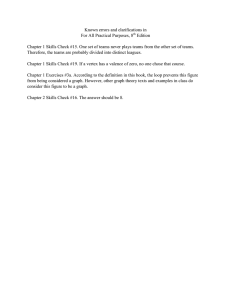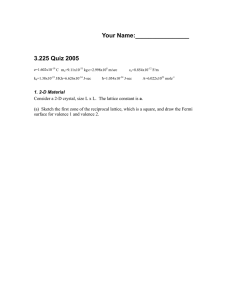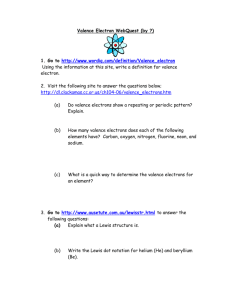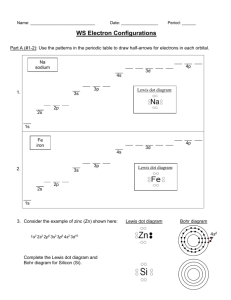VALENCE TAUTOMERISM WALLACE
advertisement
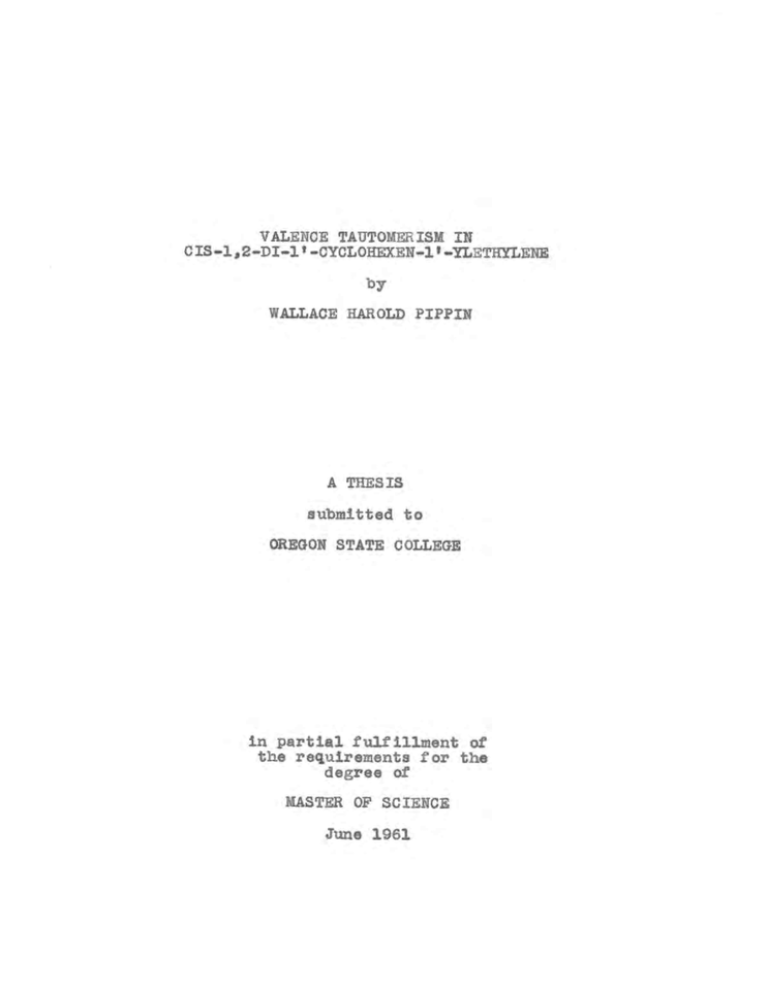
VALENCE TAUTOMERISM IN -YLETBYLENE C IS-i, 2-DI-i' -CYCLOHEX.EN-l' by WALLACE HAROLD PIPPIN A THESIS 8ubmitted to OREGON STATE COLLEGE in partial fuit illxnent of the requirements for the degree of MASTER OF SCIENCE June 1961 APPROVED: Redacted for privacy Aìooiate Professoi' of Chemistrj In Chargo of MRjor Redacted for privacy Chairman of Department of Cernistr' Redacted for privacy f, Chairnan of 5chool Grnñiite Committee Redacted for privacy Dean of Graduate Dato tbe1s is proented Typed by F. Eleanor Jones choo1 upust 1960 AC KNOW LEDGMENT My sincere thank5 to Dr. E. N. Marvell without whose supervision and guidance this thesia would not have been possible. I standin would also like to thank my vII'e who .ìndor- and patience made the completion of this work possible. TABLE OF CONTENTS PAGE INTRODUCTION . . . . . . . . . . . . , . . . . HITOICAL . . . . Intra-nnuiar . . . . . . . . . VRlence Tautoinerism Ring-chain Valence Tautomerlam. D ISCUSSION . . . . . i . . . . . . 3 . . . . . . 3 . . . . . . 6 s s s s e 12 . s s u S Trione Preparation. . . . . . . . . . . . . . 12 Thernial Study . . . . . . . 16 s a a a 22 l,2Di-11-hyàroxycyc1ohex1'-y1ethylene . . . 22 7-Oxadispiro(.l..2.)pentadec.1t4-ene . . . . 22 1,2-D1-1'-cyclohexen-l'-ylacetylene . . . . . 23 1,2-Dicyclohexylideneethane . . . . . . . . . 23 Diborane Reduction. . . . a . . . 2L EXPERP4ENTAL . . . . . . . . . . . . . . . . . . . . . . . s . s . . . . Cls-1,2-di-l'-cyclohexen-l'-ylethylene. . . . 2 Thermal Study . . . . . . . 26 Preparation of Diels-Alder Adduct . . . . . . 26 a a s s 28 . a a s T.ThT!!íRY. . . B IBLIOGRAPHY . . . a u a s s a . . . . . . . . . a . . . . . . e i a . . . . . a 29 VALENCE TAUTOMERISM IN C IS-]. ,2-DI-1' -.CYCLOHEXEN-1' -YLETHYLENE INTRODUCTION Two content, truetu.rea, having approximately eua1 energy and dtt'foring only in the position e1octron, ol' are ordinarily hybrid. On terned canonical £orm the equilibrium certain pairs a resonance other hand if two atructures differ in the order of attachment of dynaìiiic o one, or more, atoms and are those, then, aro tautoniers. However, of struotures whieh differ only assigned position of in electrons, but whose in the interconversion necessitates an activated change in conformation belong in neither category, and have come to be known as valence tautomers. well this phenomenon is the photoequilibrium between ergosterol (I), precalciferol A known example of (II), and lumisterol (III). HI The a literature of organic chemistry contains only very few ndequately studied cases of valence tautomer- isni. In view of its importance to both theoretical and synthetic organic chemistry, valence tautomerism deserves more careful Investigation. This study marks the initiation ol studies of this phenomenon. a series of This thesia describes some attempts to approach the triene cyclic-diane system from the triene side using i-1,2-dil'-cyclohexon-l'- ylethylene as substrato. This substance was chosen because of its availability and appropriateness of conformational arrangement. 3 RITO PICA L The concept of valence tautomeristn was first introcucod by Ingold (]., p. l28-19) in 1922, Bnd since Baker (3, p. 201) has divided the examples Into two distinct classes, nwnoly, intra-annular v1ence tautomar- lam and ring-chain valence tautomerisru, this will Le continued in this section. Intra-annuler Valence Thutomerism Intra-ennular valence tnutomeriin has been studied in 6, r 8 and 9 7, carbon cycloalkanea and will be up in order of carbons in the largeat cyclic system. CoH cOH ÇL H3C\l C;21 '-o,H H3<j H M oH H 'COH H C 01H Ff3 \T:tcH ço H.9/ H\ ozè J c: o1H tken 1. Ingold and Thorpe (1g, p. 128-1S9) in 1922, studied the reactions of a compound that exhibited chemical characteristics of both (IV) and (V). Upon oxidation with potassium ferricyanide are obtained. (VIII) and (IX) evidence lead Ingold to postulate that there may be tautomeric equilibrium between (IV) and (V). is s valence tautonieristn and (VII). a this rests upon the assumption that both (IV) nnd (V) exist principally in their (VI) That Thie eno]. forms, However, no physical evidence was given to substantiate this premise thus making their conclusion of a somewhat tenuous nature, Recently Cristol and Snell (9, p. l9O-l92) have shown that irradiation of (X) gives its valence tautomer in good yield. Xl X CO2H CO2H D2H They did not ascertain whether an equilibrium mixture in formed but it does not appear probable. investigation of this interesting prcss Further in in order. s In 1956, Corey and Burke (9, p. 180-.182) made an extensive study on v2rious derivatives of eucarvone ¿nd carene. Although ultraviolet spectra and nucieRr maj'netic resonance studies failed to show any of (XIII) in equilibrium with (XII), deuterium exchange experiments indicated that a small amount of (XIII) was Flctuahly present. XIII xH 3 H In the most satisfying CH3 study yet made, Cope, Haven, Ramp, and Trumbull (7, p. t1867-*871) proved beyond any doubt that valence tautomerism exists in the 1,3,5-cycloocta-- triene and bicyclo (I.2.0)octn-2,I-diene system. By approaching the equilihrium from both sides, and by isolating and identifying the resultant products, they were able to demonstrate conclusively that the equilibrium mIxture contains 85% (XIV) and 15% (XV). xv Two xv years later Alder reported that if and T)ortmann the diene (XVI) (1, 19O-l9l6) p. were subjected to Hoffmann degradation (XVII) and (XVIII) were formed. They did not investigate any nossible equilibrium between these two nor did they isolate the triene (XVII) in pure XVII xv' XVII H3)2 form. It is not clear therefore whether the bicyclic diene arises from the triene or directly via annular eliminaticn, It is quite possible a trans- that the mixture isolated is nctually an equilibrium mixturo. Mng-chain Valence Tautotnerism In 1928, (XIX) while studying the derivatives, postulated a Ingold and reactions of Shoppee (iti., phorone p. 36S-LO9) nossiblo new type of valence tautornerism. 7 They called this phenomenon ring-cnsin valence tautomerism, which is self-explanatory, and proposed the following scheme for its occurrence. XX XIX + H - , H3 3 H) H3 'CH3 Pgain their evidence is of o rather tenuous nature, and is based upon the following sequence of reactions. C+ XIX (X X) I PHIO The isolation of a cyclopentanone under acid con- ditions Is not particularly convincing evidence for the presence of a blcyclo (2,1,0) pentane ring and in lieu of further evidence this kind of valence tautomerism must be considered highly doubtful. Vogel (2L, p. 14l3-1lL) has proposed that in the dimerizatlon of butadiene to 1,S-cyclooctsdiene 1,2- divinylcyclobutane intervenes as an intermediate. In an xxH XXI attempt to substantiete this theory he subjected the cyclobutyl derivative (XXIII) to Hoffnann degradation, N(CH3)2 > (XX I) (XX II) N(C H3)2 and reports that the product Is (XXI). then, mixture of (XXII) and However (XXI) was nover isolated. we can only occur, but V.00ds p. a surmise alternate (28, p. Once again, that the expected reaction did mechanisms are obviously possible. 38O-14381) in 19S6, and Alder 19S-21) in 197 have both v1orked on (2, bhe pyrolysis of mono and dimnethyl substituted hexatrienee and their precursors. The following are two examples of the reactions they studied. Q A 0 I H H3Ç HÇC H = H AcO 3S° ÇH3 5000 H3 HÇ 0Ac Although the product of the latter of these two reactions is the valence tautomer of the expected cis-triene, the conditions are too drastic to pernit any useful conclusions concerning valence tautomerism in this case. Certain other suggestive information is to be found in the Thu8 lt is (6, p. ¿22O) thnt cyclobutene is readily isomerized to butadiane. reversal has not been reported. The Recently Overberger and Borchert (21, p. 1007) found that heating (XXIV) formed cyclopentene rather than the expected vinylcyclopropane. They propose the following tautomeric equilibrium to account for this result, but this mechanism is not backed XXIV <: by experimental evidence. iiI c lo Certainly the best documented example of ring-chain valence tautomerism is the ergosterol, lurnisterol, precalciferol series. The first study of the irradiation in 1930 (27, p. 17-30). of ergosterol as made by Windau The structures of intermediates in ergosterol to vitamin controversy. have )eOfl the conversion of the focus of much In 19L9, Velluz and co-workers 507), using precisely controlled conditions, (22, p. 501- were able to With the help of the shed some licht on the problem. additional studies of Inhoffen (16, p. 396-397) and Havinga (12, p. 1230-1237) the following equilibria have been potu1ated. I-1 D I Il Th15 is clearly a ring-chain valence teutomorisni and it shows that the ring closure, at least that catalyzed by ultraviolet light, proceeds In a trans manner. Due to the instability of the substances involved, however, the proof of the relations between these substances is as yet somewhat tenuous. 11 Dauben (10, p. L.O6O-ÌO6) In has concluded that, "In ßeneral, tautomer of diene ja very recent article the saturated valence stability of iteb1e, whereas the an unsaturated tautotner depend9 upon the number, location, This statement and type of substitutents on the systemtt. is bssed lcrgely on work done by Vogel (2g, p. 6Lo-6Li) in which he postulated the need for a conjugated system if the valence tautomeric forms with ease. re to be interconvertable This is indicated by the easy thermal conversion of cyclooctatriene and cyclononatriene to bicyclo (L.2.0)-octa-2,L4-diene end bicyclo (L.3.0)nona(3.2.0)hepta- 2,L-d1ene respectively vhi1e both bicyclo 2,6-diene and bicyclo 4.2.0)-octa-2,7-diene are stable to 1600. 12 DISCUSSION The major portion of this thesis is concerned with the preparation of cia- and trans-1,2--di-l'-cyclohexen- l'-ylethylene, and the initial attempts to study the valence tautomerism of the former isomer. section will be divided into at a Thus this discussion of the attempts synthesis of the desired compounds and of the resulta of the valence tautomerjsm studies, Triene Prepert1on The synthesis of Qj-1,2-di-1'-cyc1ohexen-1'- 1ethylene has been reported (17, p. 1Lj18-1I2) by the partial reduction of l,2-di-1'-cyc1ohexen-1'-y1acet1ene. The use of semihydrocenation is indicated since it is the only generally applicable route to clisubstituted cia- ethylenes, and palladium is the catalyst of choice. How- ever the semihydrogention is not as satisfactory as might The rate be expected from the simplicity of the process. of reduction of the triple bond and of the resultant conjugated triene system do not differ markedly, and the catalyst frequently brings about version. a ci to trans intercon- Inhoffen reports that the trieno is sensitive to air and light and the nature of the catalyst remarkably influences the yield and purity of the desired gi 13 1omer. a Furthermore he reports that attempts to provide pure sample by chromatography on alumina give unsatisfactory results, The results obtained in this work serve to confirm Inhoffen's work in most particulars. Thus the Lindlar catalyst gave both cia and trans isomers. A normal palladium catalyst gives overhydro,enated products, unchanged starting material and j-triene, but rione of the trans isomer as indicated by the ultraviolet spectrum. A careful repetition of the hydrogenation as nerly accord with Inhoffen's best directions as possible in ave a sample of cis-triene contaminated principally by 30% of unreduced acetylene. Since there is no Indication of overhydrogenated material this appears to be the result of interrupting the hydrogenation a little too early. However the pure cis-trione was never obtained by catalytic hydroenation in our hands. Recontly Brown (Li., p. 1512) has reported that diborarie adds to an isolated triple bond giving the pure oleuin upon hydrolysis with acetic acid. the conjugated diene-yne used here is Although drtical1y differ- ent from an isolated triple bond it is possible that diborane might react in also. s similar manner in this instance Using Brown's method of preparation of diborane the reduction was attempted at three different temperatures, 14 0°, 250, wa sterting material, identified by ita ultraviolet f30. roduot uff1cient yield to th spectruni, The only product i3olated in eaci caae suggt th2t no other ca rorn!ed. Evei t1ough these result3 are negative, a torouh invetition conc].usion a reagent conjujated should be made berore any definite drawn concernn i the value or dthorane as the preperetion of ois double bonds in l'or systoriis. As mentioned oarli3r, dienyne with a a Dartial hyrro»nton Lindlar catalyst gives a mixturo the of ol' complex This spectra can be interpreted as ultraviolet apectra. iridicting moz'e mixture of both ois and trans 1,2-di-1'-cyclohexen.'lylethylene. soiners of To confirm this pcint a serp1e of trana-1,2-di-l'-cyclohexen-l' -ylethylene seemed desirable and its synthesis was atte;rtpted therefore. The first attonipt at synthesis of this compound consisted of heatn a solution of cia-1,2-dl-1'- hydroxyeyc1ohex-1'-ylethï].one (XXV) in xylene with floridin. The product obtained £'a.1ed to show any ab- sorption peak above 220 was noted. The iu. and only strong end absorption üfraaO() pectr showed a peak at 1095 cm"1 which indicated that this was undoubtedly the diapirodihydrofuran (XXVI). i xxv xxv OID Reduction or 1,2-di-1'-cyc1ohexen-1'-yicetyine with sodiuin in liquid ammonia was studiad a direct synthesls of the trans triene. (13, p. 2020-2022) and Campbell (, a D0831b10 new And Greenlee p. 216-216) heve shown tnat the pure trans olefins are obtained in excellent yielcJ8 when this method is used on isolated triple bonde. It was hoped that tue di-siilon formed from the adc3ition of two mole eqtiivalents of sodium to the triple bond would not only be trans ïn nature but also would protect the system from tny further addition of sodium, since lt Is n rnther well known fact that sodium may reduce conjugated triene systems. Instead of the desired trans-triene, however, the product, when purified, spectrm(l9, p. of differential product a O7-O8) ws Identified by as the diene is ultraviolet (XXVIII). By use 1traviolet analysis of the initial small amount of (XXIX) vas elso detected (23, p. 881-886), but not isolated. 16 XXVII XXIX (h o The simplicity of this process and the reasonable yield of pure (XXVIII) obtained make this the most convenient synthesis of that compound yet devised. In view of the excellent yields obtained in this reaction, further study on other conjugated acetylenes might prove profitable. Thermal Study The energy needed to bring about a valence tautonieric change may be supplied either a ultraviolet 1iht. a thermal energy or by For conversion of a mobile compound to more rigid isomer the thermal process is probably more efficient. A moderate temperature (180_2000) was chosen for the initial experiment in order to minimize alternate reaction possibilities. niaximt.&in the ultraviolet Since the cis-triene has only one (214.8 mp) and homoannular dienes generílly exhibit complex spectra with the major peak near 283 i, the use of ultraviolet spectra to follow the 17 X: process is obviously recommended. In oder to minimize any bimolecular reactions (po].y- merization, etc.) and to insure maximum probability for the intramolecular valence tautomerism wns employed. For this purpose a a dilute solution solvent, high-boiling transparent in the ultraviolet was necessary and highly purified hexdecnne ws therefore utilized. A 0.0011 M solution of l,2-di-l'-cyclohexen-l'- ylethylene containing 3O l,2-di-1'-cyclohexen-l'- ylacetylone in hexadecane was heated at 1800 for two hours taking samples for ultraviolet analysis at 20 minute After only 20 minutes the triene maxima had intervals. almost completely disappeared and a totally new ultra- violet spectrum was obtained (see Figure 1). 1' new maxi- mum at 301 mr had appeared along with an inflection at 287 mp and From 261 m a considerablç increase In absorbance at 278 mp. to 220 mp the spectrum appeared to he virtually identical with that obtained from the diene-yne. Upon subtraction of the diene-yne spectrum from that of 18 the heated sample, reference point using the region around 220 m for both spectra, subtraction curve). a curve was obtained These were at 273 mp, having four distinct maxima. 278 mp. 288 mp and 301 mp a as respectively (see Figure 2, This new curve is almost super- Imposable upon that of ergosterol except that it has shifted 6 mu toward the visible (Figure 2). In ordor to verify that the above result ws not duo to reaction of the triene with the diene-yno, a second thermal study was made using the pure diene-yne as substrate. After 8 Fiours of heating at 190-19° only genral dropping off a In absorbance was noted which was best interpreted as due to either polymerization or degradation of the diene-yne. Assuming that the new substance obtained from the eis triene has an extinction coefficient similar to that exhibited by ergosterol, the yield of hornoannular diene minimum valuo. after only 20 minutes amounts to 70% as a This shows that at 180° the homoannolar diene is constituent at equilibrium, a the major result expectad because the calculated heats of combustion of the two substances shows the cyclic form to be more stable by approximately lOkcal./mole. It is also of considerable intersat that no evidence can he found for the presence of trans-1,2-di-1'- cyclohexen-1'-ylethylene in the heated sample. w o z o (I) OEl 220 240 280 260 WAVELENGTH, mp Figure I: THERMAL STUDY 300 320 [i] [o] [o] u o I i [i] [o' WAVELENGTH, Figure 2 mp 21 In order to confirni the deductions from the ultra- violet apectruni, it would be desirable to isolate either the resultant product or sorne derivative of it. Since the hydrocarbon Is extremely difficult to separate from the hexadecane, a derivative with lndicted. It is .'ell-knovm onie functionality waa that homoannular dienes undergo the Piels-/1der reaction with considerable facility while the ç4-triene and the diene-yne are much more reluctant to enter Into that reaction. Therefore the mixture of triene and diene-yno was heated with an excess of nialeic anhydride for 14. hours in boiling xylene. After saponification of the anhydride an acidic inate'ia1 was isolated which readily lactonized in aqueous solution. This is undoubtedly an adduct but it has not yet been sufficiently characterized to permit identification. 22 1XPT PIMENTAL ],2-t i-,].' -1 ydrcxjcyc1ohex-.1' -1cthy1one Ten -rcnt (O.Ot7 molos) of 1,2-di-1'-hydroxy- dio1ved cyclohex-.1'-ylacetylcne were 8nd 0.1 g. of nalltdlum OT) in ethyl ncotate, (%) c1c1urn carbonate ws p8red aceo'ding to r3indlar (18, p. 146-'LO), W3 uptake flyc3ropon The catiyt white crystalline mcteriiil, l3-l5!°) (17, wae renovec1 ane the 8olvent evaporated in vacuo. Pecrystnllizatlon from inethanol-wnter cuve 9. a added. arbitrarily intcrrupted ofter the addition of one mole eauiv3lent. b- filtration, pre-. rn.p. lh-]54° g. (9%) of (Lit. p. ]J48.-l12S). 71-Ox&u'iapiroJ5.1.5.2. )pentadec-lLt -ene Three of rarna 1,2_di_1_hydroxycyc1ohex_1 '- ylothylcne we'e d1aolved in warm xylene and the mixture p1acd in p 20C) m]. f1isk fitted with an e1eib1c and a reflux condonaer. of floridin were added and Five tram the ndxture refluxed for aevoral hours wIth conetant stirring. (l.'2 Fir), in vacuo, 'ave 2 . v:lien no further wnto waa romoved an nzeotrope the colution was filtered, nd the reu1tnt the xylene evaporated viscous oil distilled. (66() of a colorless oil, b.p. 92° absorption in the ultraviolet, £220 OOO. This (O.rim.),end Gee-phase 23 chromatography (6 ft. type K column at 2000) showed only liSO one peak (apparent reten. volume sorption at l09, 738, 90S, 993, 1.91O (Lit. n2OD 1.1908) ml.), I.e. ab- 1363, lL50, 2930 cnf7,', p. 2666-2672). (20, 1,2-Dl-1 '-cyclohexen-l'-ylacotylene The i,2_d1_i?_cyciohexen_1_y1acety1ene was best prepared according to the procedure of Marvel (20, Five grams or p. 2671) with certain modifications. 1,2-di-1'-liydroxycyclohex-l'-ylscetylene were added to 2S ml. of 140% sulfuric acid and the mixture refluxed for 30 minutes. The reaction mixture (two distinct layers) was extracted thrice with 0 ml. portions of ether and the combined ethereal solutions dried with anhydrous sodium The ether was evaporated and the resultant sulfate. yellow oil chromatographed on activity alumina (0 103L0 (0. (1S,08O), 262 mp (Brockman) g.) using petroleum ether as eluent. Distillation yielded b.p. I 22-23 3 g. (60%) or mm.), 2'max 263 in)i (18,900), 276 a mp (20,800), (16,000), n20D m,p (lLi.,830); colorless oil, i.S8 n20D 276. (Lit. 1.5L19) (17, p. ]J48-1L2). 1, 2-Dicyc1ohexylidenethan e A solution containing 1.00 g. (0.0SL mole) of mi max 214 l,2-dl-1'-cyclohexen-1'-ylacetylene in 30 ml. oV tetrahydrofuran was placed in with a rr'r-Ice-coo1ed a 3-necked flask, provided dropping funnel. flushed with nitroRen and immersed In Approximately O ml. dropping funnel and The flask was a r'ry-Ice bath, ws of liquid ammonia placed in the or rinely divided sodium OO mg. was dissolved in the ammonia. nieta]. This solution was added blue color The rapidly to the reaction mixture. dis- appeared almost instantaneously and the reaction mixture crcduall turned a Immediately after the deep red. 2-3 addition of all the sodium, rnmonium chloride of m. was added and the temperature. The tetrahydrofuran solution wcs filtered to mmonia was allowed to ev&porate at room s1ts remove insoluble Listillation yielded b.p. 80-85° (0.25 00. (Ç6%) and the solvent removed. 0.614 g. (614%) (26,650), (Lit. 2149 n 2I.l colorless liquid, upon cooling to petroleum ether gave 0.56 g. of white crystals, m.p. (37,600), t solidified mm), which Recrystallization from 2149 m,i of m3 1414-145° C, (31,1400), (38,100), 259 my (Lit. 145-146°), and 259 mj (26,600), 214 my (31,600) (19, p. 507-08). Diborane reduction The procedure followed for the reduction of 1,2-di- 1'-cyclohexen-l'-ylecetylene, was a sli,ht1y modified 2 version of that repoìted by Brown added to 75 ml. of u 0.0089 M solution of sodium boro- hydride In totrahycrofuran in flask One gram p. 1'12). of 1,2-d1-1'-cyc1ohexen-1'-y1acety1rne, was (O.O5L. mole) The (1f, immersed in ws a 2OO-ii. 3-necked flask. ice, flushed with dry nitro;en, and 0.122 g. (0.00086 mole) of boron trifluoride etherate added over period of a minutes at û a i. After an additional 30 ììour. small anount of ethylene glycol was to destroy any unreacted hydride. added Five milliliters of glacial acetic acid were added (maintaining the nitroen atriosphere) bath. and the mixture left over nicht in an ice The solution was washed with three of water, O.6!4. g. vacuo and the residue distilled. (6L%), resulted, The above procedure wa In each case only A colorless which was identified by its ultraviolet spectrum as starting (5% ml. portions dried with sodium sulfate, the solvent evaporated in oil, O run material. at 20 and starting material could be at and isolaed and 6)% yield respectively). Cis-1,2-di-1 '-cyclohexen-1 '-ylethylene This was prepared according to the procedure described by Inhoffen (17, p. l).23). 0.78 g. (78%) of a colorless oil, 21i.9 my (11,600), (Lit. Distillation save b.p. 76-79° (0.2 2L8 (11,200) mm), 26 (17, 1L18-1t2). p. (11,OO) an at 276 Further ebsorptlon at 261 (1) Indicated the presence of n eome unreduced starting naterie1. Thermal tudy One hundred milliliters of a 0.0011 molar solution of cla-1,2-di--1'-cyclohexen-l'-ylethylene containing 30% of 1,2-.di-1'-cyclohexen-l'-ylacetylene was heated to 180-. 1900 In a nitrogen atmosphere for 10 hours. sample of the solution A i ml. taken every 20 minutes for the wtì first 2 hours at which time the intervals were extended to i hour for the next 8 houre. 214.9 mu peak of' After 20 mInutes the the cis-triene had completely disappeared and new peaks at 273, 278, (cf. Figure 1 and 2). 288, and 301 mp had appeared Further heating led to diminution of all peaks above 220 and ultimately to complete loss of the enk at 301 mp. Preparation of Dials-Alder Adduct A sample of' 1.6 g. (0.00814. mole) of ois-1,2-dl-1'- cyclohexen-1'-ylethylene was hydrogenated in the prescribed manner and the solution, after filtration, added to 300 ml. of xylene. To this was added 1.7 . of malejo anhydride and the solution brou;ht to reflux at 138° (distilling off anything under this temperature) C. :d held 27 there for in vacuo. 14 hour8, after which the x1ene was distilled The crude product wes wirmed 3 times with lo ml. rortions of 1O the ICOR, solution8 acidified with SO times with ether. combined 8lkaline HC1 and extracted several After evaporation of the ether the resultant solid was recrystallized from anhydrous ether yielding white crystals, m.p. 2122lJ10, infrared absorption it 1710 cm. Upon addition of petroleum ether to the supernetunnt liquid n secnd crop of light yellow crystals was obtained, m.p. l8Ol830, infrared absorption at 1710, 1676 cm. Recrystallization of both these materials from acetone-water yielded white crystals, r.p. 96-97°, infrared 930, 784, Anal. 76 absorption at 1762, 1092, bitO, cm1. C&l'd for C18J122O Found: C, %; z H, C, 7l.%; II, 7.3% 9144, 28 A sample of cis-1,2-di-1'-cyclohexen-l'-ylethylene has been prepared by semihydroenat1on of 1,2-dl-1'- cyclohexen-1'-ylacetylene according to the directions of Inhoffen (17, p. lL1l8-lL2). This sample was contaminated by about 30% of unreduced starting material. A dilute solution of this mixture in hexadecane was heated at 1800 and evidence Indicating that the following reaction occurs rapidly and in high yield was obtained. The contaminant does not interfere with the reaction. Incidental to this work an unsuccessful atteript to bring about semlhydroenation of 1,2-dI-1'-cyclohoxen-l'- ylacetylene via hydroboratlon was made. An attempt to produce trcns-1,2-di-1'-cyclohexen-l'-ylethylene by reduction of the acetylene with sodium in liquid ammonia gave a good yield of l,2-dIcyclohexy1idenethCne. constitutes an extremely convenient synthesis of substance. This tls 29 BIBLIOGFAPHY 1. Alder, Kurt and Aciolf Dortraann. iiber das Cyclo- und seine intra- nonatr1ene-(1.3..)-(c1s,c1s,trins) Chemische Berichte 87: cyclischo Diene-Syntheses. 19O-19].6. 2. aber olnige elniache Alder, Kurt and H. von Brodel. Triene, ihre Konfiuration und ihr Verhalten bie Justus Liebigs Annalen der Chemie 60e: Dien-synthesen. 19-21S. 3. Ii. ;. 6. l97. Baker, John William. Routledge and flona, Tautomerism. 332 p. l93t. London, George Brown, H. C. rv G. Zweifel. The hydroboration of' acetylones. Journal of the Arnrican Chemical Society 81:1512. l99. The Ca,phell, Kenneth N. and Liurence T. Elby. Journal olefins. trans preparation of h1her 1914. of the Amurican Chemical Society 63:216-218. The thermal. Cooper, balter cnd W. D. Welters. of the American Journal of cyclobutene. isomerization Chemical Society RO:L22O. 198. 7. 8. Valence tautomerism of 1,3,Cope, Arthur C. et al. end bicyclo (L.2.O.)octs-2,1-diene. cyclooctatriene Society 7J4.:L867-I4871. Chemic]. American the of Jourruiul 19S2. nd H. J. Burke. The nature of the ring Corey, E. J. bridging step in the transformation of eucarvone to Journal of the ¡\merican Chemical carene derivatives. Society 78:180-182. 9. 196. Bridged Cristol, Stanley J. and Robert L. .ne1l. of photoisomerization The polycyclic compound3. VI. acid bicyclo(2.2.1. )hepta-2,-diene-3,-dicarboxy11c acid. to quadricyclo(2.2.1.0.0. )heptane-2,3-dtcarboxylic 80:19O-192, 'ociety Journal of the American Chemical l98. lo. Dsuben, Wil1im and Gerhard J. Fenken. The structure of photoisopyrocalciferol and photopyrocalciferol. Journal of the American Chemical Society 8i:O6OtO68. 1959. 11. 12. Fieer, Louis F. York, Reinhold, nd Mary 199. 9! Fieser. Steroids. p. Havinga, E., J. L. Koevoet, and A. Verloop. Iew studies vitaniin D and reicted conipounds. Recueil des traveux chimques des Pays-Bas 7L1:1230-1237. l9. on 13. iLk, 1. Henne, Albert L, and Kenneth W. reenlee. Hydrogenatlon of the triple bond. Journe]. of the American Chemical Society 6:2O2O-2O22. 19li3. Ingold, Christopher Kalk nd Charles William hoppee. On the possibility of ring-chain valency tautomerisni type of mohile-hydroon tautomr.sm and of analogous to the Wagner-Meerwein rearrangement. Part I. Sorne derivatives of phorrrne. Journ1 of the Chemical Society 1929, p. 36-1.O9. Ino1d, Christopher Kalk, Ernest Rarold Fprnier and Jocelyn Field Thorpe. The chemistry of polycyclic structures in relation to their homocyclic unseturated Isomerides. Part II. Intra-annular tautomerism. Journal of the Chemical ociety 1922. 121:l28-19. 16. Inhol'fen, Hans Herloff. Zur Photo-Isomorl8ierung der Provitarnin D. Die Naturiwissensehalten L3: 396-397. i 956. 17. Inhoffen, Hens Herloff and Gerhard Quinkert. 5tudien in der Vitamin D. Reihe. VI. Modelsynthesen zur Fragen den cis-trans-Isonierie beim Tachystorin. Bichte Chemische L6. 87:lL1ß-l12. 195).i.. Ein neuer Katalysator fur selective Hydrierungen. Helvetica Chimica Acta 3:14L6-LSO. Lindlar, H. 19S2. 19. Lythgoe, B., Synthesis of vitamin 20. 21. D. . a Trippett, and I. T. Harrison. triconjugated triene related to Chemistry end Industry i9S, r. 37-O8. Marvel, C. . et al. Cyclization of dienynes. V. Hydrop"-ennnthrenes. Journ1 of the American Chemical Society 9:2666-2672. 1937. Overberger, C. G. and I. E. Borchert. Novel thermal in rearrangements accompanying acetate pyrolysis Chemical American the of Journal small ring systems. 31 1960. SocIety 82:1007. Velluz, Leon, Gaston JrnIand nd Andre Petit. Ses relations d'd'cuilibre avec le cc1c1fro1. Bulletin de la 5ocIt Chimique de France 16:0l-07. 1%9. 23. Viscontinl, M, and H. P. Burgherr. Darstellung und Eigenschaften des 1-(cyclohexen-l'-yl-l' )-2--cyclohexyl-ithey1ens. Helvetica Chimica rCt8 Lo:88i-886. 22. 197. 2I,. Vogel,Ernanuel. Dimerizatlon 11tl. 2. zum liber den Mechanisiurns der 3utadiene- 8-Rin,, Angewante 196. Vogel, Emanuel. Liber die Stabilitate ungesattigten Koh1enstaff-Vierrinps. Chemie 66:6Lo-64, 26. Chemie 68:I13- des Ancewante 19SL. Windaus, P. ond H. Luttrinhaus. liber das Verhalten dea Erosterins und einiRer seiner Derivate geenuber Melelneaure-snhydred. Chemische Berichte 6L:8o-8I. 1931. indaus, A. et al. liber einige krysttillIsiert Restrahlungsprodukte aus Ergosterin und Pehydroergosterin. Justis Liebics Annalen der Chemie t83:17-30. 1930. 28. Wooda, G. F. and Alfred Viola. Dimethy1-1,3,hexatrienes. Journal of the Jmerican Chemied Society 78:L380-14381. i%6. 27.
